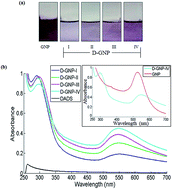Synthesis of diallyl disulfide (DADS) induced gold nanoparticles: characterization and study of its biological activity in human leukemic cell-lines†
Abstract
Novel approaches to nanoparticle synthesis using herbal products and their potential application in treatments are now in the limelight of recent cancer research. Diallyl disulfide (DADS), a bioactive component of garlic has been used for centuries as an effective remedy for different ailments including cancer. In the present study, DADS is used to synthesize less toxic, eco-friendly gold nanoparticles having anti-proliferative effects against cancer cells. DADS induced gold nanoparticles (D-GNPs) display a characteristic surface plasmon band near 551 nm which is 22 nm red shifted compared to conventionally prepared gold nanoparticles (GNPs) using tri-sodium citrate. Moreover, the hydrodynamic diameter of D-GNP ranges from 70 to 77 nm and its zeta potential is −24.6 mV. A nearly spherical ultra-structure of D-GNPs was visualized under atomic force microscopy and transmission electron microscopy. FT-IR analysis confirms the association of the sulfur group of DADS with these nanoparticles. D-GNPs show dose dependent cytotoxicity in human leukemic cell-lines U937 and K562. Cellular uptake of D-GNPs in U937 leading to nuclear fragmentation and DNA ladder formation are other insightful findings. This report therefore details the synthesis of stable gold nanoparticles using DADS and reveals D-GNPs to be a highly effective anti-proliferative agent showing apoptosis in human leukemia cell-lines.


 Please wait while we load your content...
Please wait while we load your content...